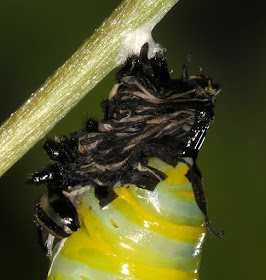The next picture shows how much change has happenned in 18 hours.
Shortly before the transformation to chrysalis is about to begin the antennae become very limp, and the area where the caterpillar is attached to the silk button looses its form.
There is a lot of small rippeling movement here through the body as the change begins inside the skin.
Within an hour of the antennae going limp the caterpillar will straighten down out of the "J" position.
Here the caterpillar has straightened down and a dark line is forming inside the skin where the skin's spiricles (breathing holes) are separating from the new Chrysalis's spiricles inside.
Within seconds of these two things happenning the skin will begin to split as can be seen in the next image.

For some reason the post will not let me write alongside the next picture, but as the skin begins to split the new chrysalis expands pushing the skin up the body.
As the new chrysalis emerges the skin is forced higher up toward the button that is holding everything.
The new chrysalis is wiggling back and forth quite a bit at this time
Here the skin is nearly off, but a delicate maneuver must happen first. The new chrysalis has a terminal black end that must move from under the skin and probe for the silk button and attach itself before the new chryalis releases its hold on the old skin, which is the only thing that keeps it from falling here.
You can see the black probe (my name for this, I'm sure there is a more proper name) has just emerged from under the skin here. It is at the top right of the new chrysalis.
I cropped and enlarged this portion of the image below.
Here you can see the probe easier, and the delicate hold that the old skin still has on the silk button.
Here the probe has pushed itself onto the silk button. the new chrysalis wiggles in circles here to get the probe attached securely.
The probe is attached now, and the chrysalis continues to wiggle and releases its hold to the old skin, which causes the old skin to fall off, and makes a more secure connection for the probe.
Here the skin has fallen and the new chrysalis is completely independant.
This whole process took only about 2 minutes but must take a lot of energy for the chrysalis. The spiracle breathing holes, the little horizontal slits, one on each segment of the abdoman, were opening and closing repeatedly while I was taking these pictures. Heavy breathing!
It is amazing to see how the future butterfly wings and antennae are already formed and can be seen so clearly.
This on what was a walking eating caterpillar 24 hours earlier
The new chrysalis begins to get shorter and fatter. It needs to work quickly before its new skin begins to harden. So it wiggles and moves the wings toward the silk button.
More wiggling, but the definition of the wings and antennae is already beginning to flatten out after only 15 minutes.
Here is the chrysalis after only one hour. It has stopped wiggling now, and the skin is taking on a hard shell like appearance.
Another post in a few days will show how the chrysalis changes with time. But since I just took these pictures, we will all have to wait to see how it looks.
Still, it already is a beautiful emerald jewel like sculpture. But it beathes.












Can your images be used for a nonprofit class project? I didn't see any creative commons notifications. Thanks!
ReplyDeleteSorry Bethany, I don't look at my comment section very often, and so did not see your comments until now. I sort of figure people will use these pictures for projects like yours. Credit for the pictures would be appreciated. Your project is probably over by now. Hope it went well.
DeleteHere is the last picture I posted yesterday just after the caterpillar let go with its ... icaterpillar.blogspot.de
ReplyDelete